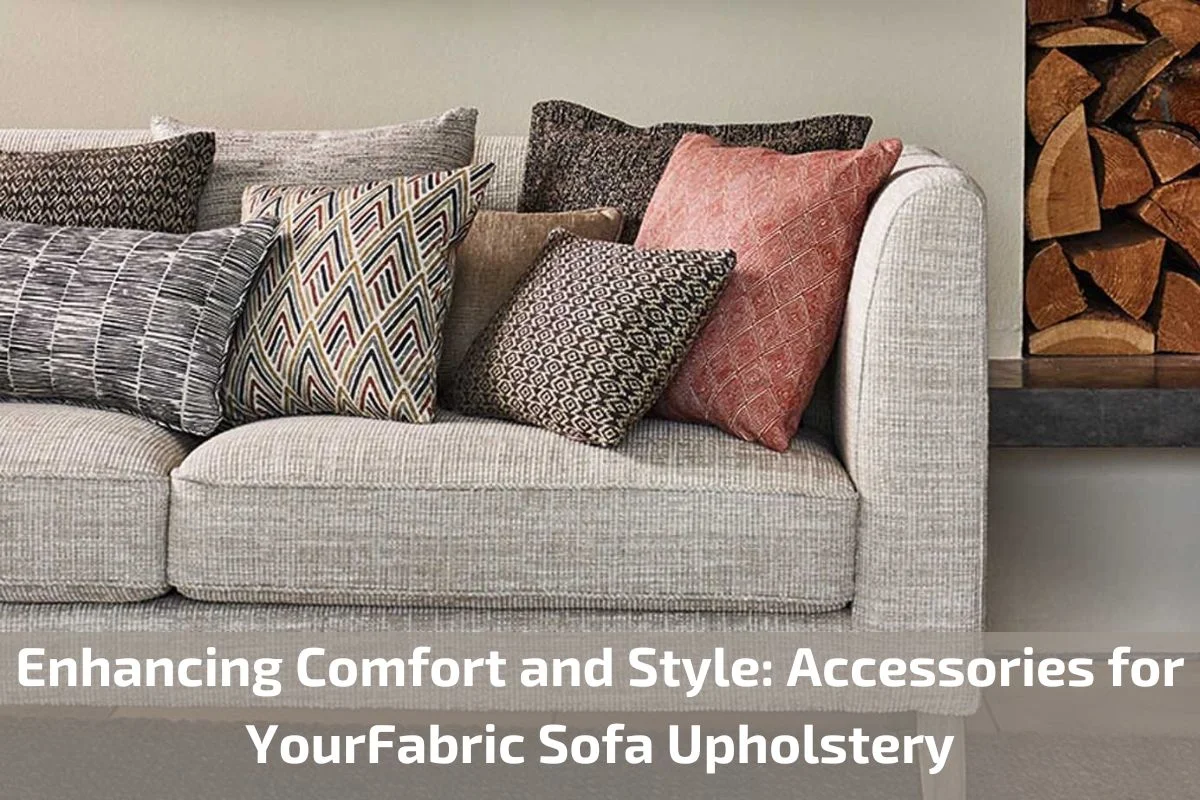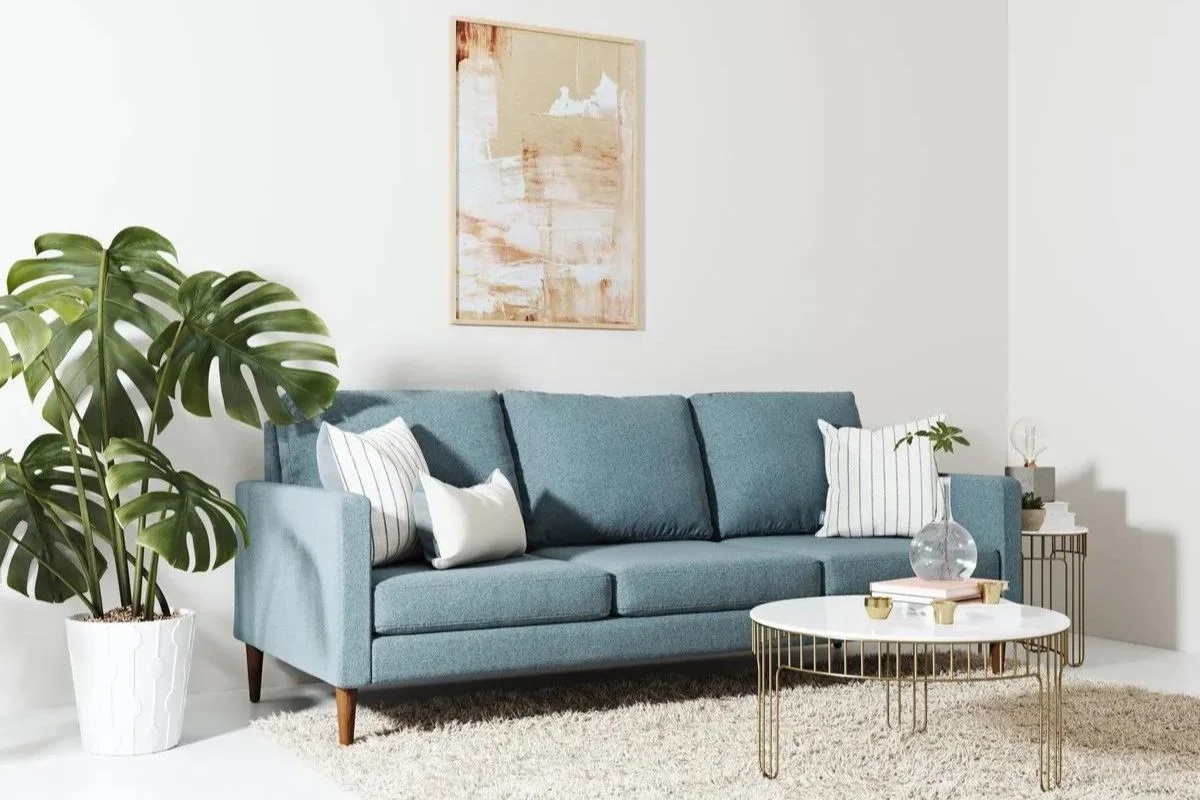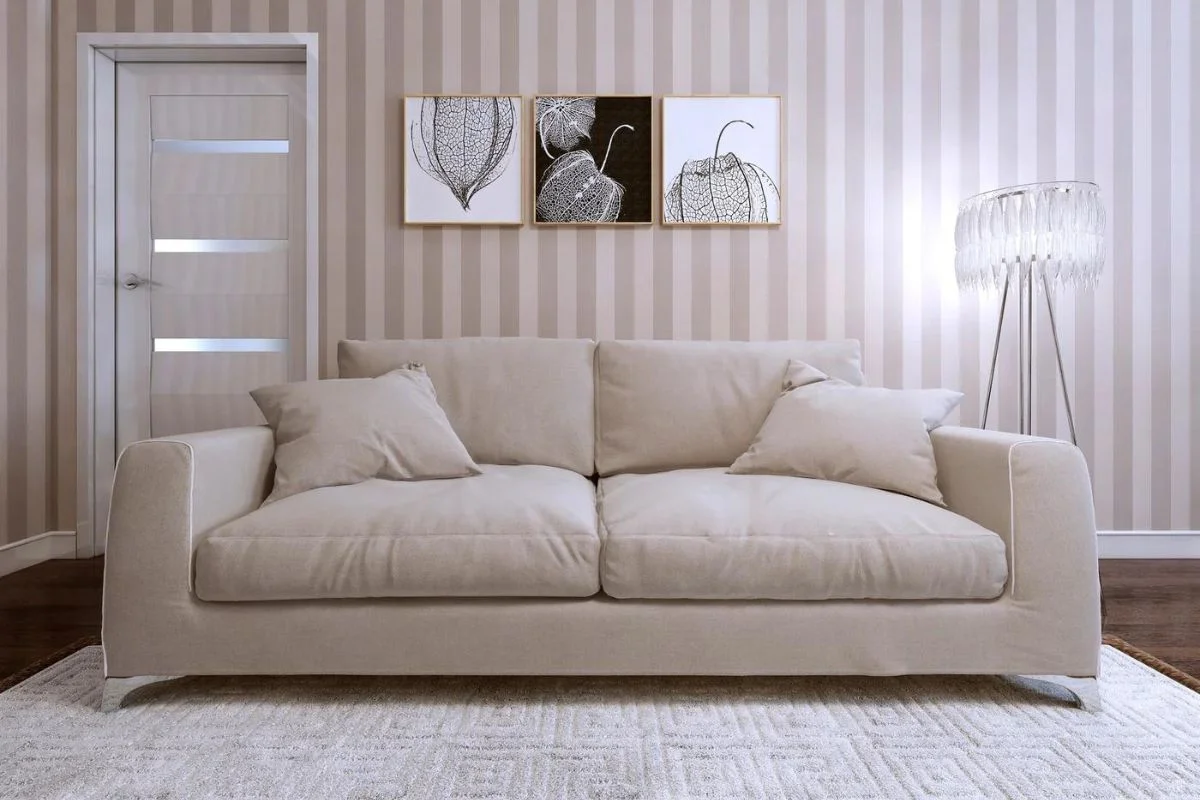Enhancing Comfort and Style: Accessories for Your Fabric Sofa Upholstery
Your sofa is the focal point of your living space, and the upholstery fabric sets the tone for its style and comfort. However, to truly elevate your sofa and create a cozy, inviting atmosphere, accessorizing with the right elements is key.
In this guide, we will explore a variety of accessories that can enhance the comfort and style of your fabric sofa upholstery. From plush throw pillows and soft blankets to stylish rugs and decorative accents, these accessories not only add flair to your sofa but also make it a more inviting and personalized space.
Importance of Fabric Sofa Upholstery
Fabric sofa upholstery plays a pivotal role in both the aesthetic appeal and functionality of your furniture. Here’s why it holds significant importance:
Visual Appeal: Fabric upholstery adds a layer of texture, color, and pattern to your sofa, enhancing its visual appeal and contributing to the overall decor of your living space. The choice of fabric can transform a plain sofa into a statement piece that reflects your style and personality.
Comfort and Softness: Fabric upholstery offers a soft and inviting feel, making your sofa a cozy haven for relaxation and lounging. Fabrics like cotton, linen, and velvet provide warmth and comfort, creating a welcoming atmosphere in your home.
Versatility in Design: Fabric upholstery offers endless design possibilities, allowing you to customize your sofa to suit your taste and preferences. Whether you prefer bold prints, subtle textures, or classic solids, there’s a fabric option to complement any interior style, from modern to traditional.
Durability and Longevity: High-quality fabric upholstery is durable and resistant to wear and tear, making it a practical choice for everyday use. Properly maintained fabric upholstery can withstand the rigors of daily life, ensuring that your sofa remains in excellent condition for years to come.
Ease of Maintenance: Fabric upholstery is relatively easy to clean and maintain with regular care and attention. Most fabric sofas can be spot cleaned or professionally cleaned to remove stains and refresh the fabric, allowing you to keep your furniture looking fresh and vibrant.
Cost-Effectiveness: Fabric sofas are often more affordable than their leather or synthetic counterparts, making them an attractive option for budget-conscious consumers. With a wide range of fabric options available at varying price points, you can find a fabric sofa to suit your budget without compromising on style or quality.
Definition and Purpose of Fabric Sofa Upholstery
Fabric sofa upholstery refers to the process of covering and padding the frame and seating surfaces of a sofa with fabric material. It involves applying layers of fabric, padding, and support to create a comfortable and visually appealing surface for sitting or lounging.
Definition: Fabric sofa upholstery encompasses the application of fabric material to the exterior surfaces of a sofa to provide both aesthetic appeal and functional comfort. It involves carefully selecting, cutting, and attaching fabric to the sofa frame, ensuring a snug fit and professional finish.
Purpose: a. Enhanced Comfort: The primary purpose of fabric sofa upholstery is to enhance the comfort of the sofa, providing a soft and inviting surface for sitting or reclining. Upholstery materials like foam padding and cushioning add support and cushioning, ensuring a comfortable seating experience.
Aesthetic Appeal: Fabric upholstery adds visual interest and personality to the sofa, transforming it from a basic piece of furniture into a stylish centerpiece for the room. The choice of fabric material, color, pattern, and texture allows for customization and personalization, complementing the overall decor of the space.
Protection and Durability: Fabric upholstery protects the underlying sofa frame from wear and tear, stains, and damage, prolonging the lifespan of the furniture. The fabric acts as a barrier against spills, dirt, and pet hair, making it easier to clean and maintain the sofa over time.
Versatility and Style: Fabric sofa upholstery offers versatility in design, allowing for a wide range of styles and aesthetics to suit different tastes and preferences. From sleek and modern to cozy and traditional, there’s a fabric upholstery option to complement any interior decor scheme.
Personalization: Fabric upholstery provides an opportunity for personalization and customization, allowing homeowners to express their individual style and personality through their choice of fabric material, color, pattern, and design. Upholstered sofas can be tailored to reflect the unique tastes and preferences of the homeowner, creating a one-of-a-kind piece of furniture.
Different Types of Fabric Used in Fabric Sofa Upholstery
Fabric sofa upholstery offers a wide variety of options when it comes to choosing the perfect fabric for your furniture. Here are some of the most common types of fabric used in fabric sofa upholstery:
Cotton: Cotton is a popular choice for sofa upholstery due to its softness, breathability, and durability. It comes in a range of colors and patterns, making it versatile for different design styles. However, cotton may wrinkle easily and can be prone to staining if not treated with a stain-resistant finish.
Linen: Linen fabric is known for its natural texture, lightweight feel, and breathability. It has a casual yet elegant look that adds sophistication to any sofa. Linen upholstery may wrinkle more than other fabrics and can be prone to fading if exposed to direct sunlight for prolonged periods.
Polyester: Polyester upholstery fabric is durable, stain-resistant, and easy to clean, making it a practical choice for high-traffic areas. It comes in a wide range of colors and patterns, including options that mimic the look and feel of natural fibers like cotton and linen. However, polyester may not be as breathable as natural fabrics and can retain heat.
Velvet: Velvet upholstery adds a touch of luxury and glamour to any sofa with its plush texture and rich appearance. It has a soft, smooth feel and reflects light beautifully, creating a sense of warmth and opulence. Velvet upholstery may require special care to maintain its luxurious appearance and prevent crushing or matting of the fabric.
Leather: While not technically a fabric, leather is a popular choice for sofa upholstery due to its durability, longevity, and timeless appeal. Leather upholstery adds a touch of sophistication and elegance to any room, with options ranging from sleek and modern to rustic and distressed. However, leather can be expensive and requires regular conditioning to prevent drying and cracking over time.
Microfiber: Microfiber upholstery fabric is made from synthetic fibers that are tightly woven to create a soft, durable, and stain-resistant material. It is easy to clean and maintain, making it ideal for households with children or pets. Microfiber upholstery comes in a variety of colors and textures, including options that mimic the look and feel of suede or leather.
Chenille: Chenille upholstery fabric is characterized by its plush, velvety texture and intricate woven pattern. It has a luxurious feel and adds warmth and coziness to any sofa. Chenille upholstery may require special care to prevent snagging or fraying of the fabric, but it offers unmatched comfort and style.
Advantages and Disadvantages of Fabric Sofa Upholstery
Fabric sofa upholstery offers a range of benefits and drawbacks that should be considered when choosing furniture for your home. Here’s a closer look at the advantages and disadvantages of fabric sofa upholstery:
Advantages:
Comfort: Fabric upholstery provides a soft and cozy feel, making fabric sofas comfortable for lounging and relaxation.
Versatility: Fabric upholstery offers a wide range of colors, patterns, and textures, allowing for endless design possibilities to match any decor style.
Affordability: Fabric sofas are often more affordable than leather or other upholstery options, making them a budget-friendly choice for many homeowners.
Easy Maintenance: Fabric upholstery is relatively easy to clean and maintain with regular vacuuming and spot cleaning, making it suitable for busy households.
Customization: Fabric sofas can be easily customized with different fabric choices, allowing homeowners to personalize their furniture to suit their individual tastes and preferences.
Warmth: Fabric upholstery adds warmth and softness to a room, creating a welcoming and inviting atmosphere for family and guests.
Disadvantages:
Staining: Fabric upholstery can be prone to staining and may require regular cleaning to maintain its appearance, especially in homes with children or pets.
Wear and Tear: Fabric sofas may show signs of wear and tear more quickly than leather or other upholstery options, particularly in high-traffic areas.
Fading: Fabric upholstery can fade over time, especially if exposed to direct sunlight, leading to a loss of vibrancy in color.
Allergens: Fabric upholstery can trap allergens such as dust, pet dander, and pollen, making it less suitable for individuals with allergies or respiratory sensitivities.
Durability: While some fabric options are durable, others may be less resistant to wear and tear, requiring replacement or reupholstering sooner than other upholstery materials.
Odors: Fabric upholstery can absorb odors over time, particularly in homes with smokers or pets, requiring regular cleaning to freshen the fabric and remove any lingering smells.
Design Ideas and Inspiration for Fabric Sofa Upholstery
When it comes to fabric sofa upholstery, the possibilities for design and customization are virtually endless. Whether you’re looking to refresh an existing sofa or create a brand-new centerpiece for your living space, here are some design ideas and inspiration to spark your creativity:
Bold Colors: Make a statement with vibrant and bold colors for your fabric sofa upholstery. Opt for shades like emerald green, sapphire blue, or mustard yellow to add a pop of personality and visual interest to your sofa.
Neutral Elegance: Create a timeless and sophisticated look with neutral-colored fabric upholstery. Shades like beige, gray, or cream offer versatility and can easily complement any decor style, from modern to traditional.
Pattern Play: Experiment with patterns to add depth and character to your fabric sofa upholstery. Consider options like floral prints, geometric designs, or classic stripes to inject personality and visual intrigue into your living space.
Texture Mix: Mix and match different fabric textures to create a tactile and inviting sofa upholstery. Combine smooth velvet with cozy chenille or add interest with a combination of fabrics like linen and leather for a unique and eclectic look.
Two-Tone Upholstery: Create visual contrast and drama with two-tone upholstery for your sofa. Choose complementary colors or contrasting shades for the base and back cushions to add depth and dimension to your sofa design.
Vintage Charm: Embrace retro-inspired design with vintage fabric upholstery for your sofa. Look for fabrics with nostalgic patterns or retro motifs to evoke a sense of nostalgia and charm in your living space.
Mix and Match Cushions: Play with different fabric colors and patterns for your sofa cushions to add personality and flair. Mix solid-colored cushions with patterned ones or experiment with a variety of textures for a dynamic and eclectic look.
Seasonal Updates: Change up your fabric sofa upholstery seasonally to reflect the changing seasons and trends. Opt for lighter fabrics and bright colors for spring and summer, and switch to richer tones and cozy textures for fall and winter.
Statement Accents: Add interest to your fabric sofa upholstery with statement accents like contrasting piping, decorative buttons, or tufted detailing. These subtle embellishments can elevate the look of your sofa and add a touch of elegance.
Custom Embroidery: Personalize your fabric sofa upholstery with custom embroidery or monogramming. Add your initials, favorite quotes, or intricate designs to create a truly bespoke piece of furniture that reflects your individual style and personality.
Cleaning and Maintenance of Fabric Sofa Upholstery
Proper cleaning and maintenance are essential to keep your fabric sofa upholstery looking fresh and vibrant for years to come. Here’s a comprehensive guide to help you maintain the cleanliness and longevity of your sofa:
Regular Vacuuming: Use a soft brush attachment on your vacuum cleaner to gently remove dust, dirt, and debris from the surface of your fabric sofa upholstery. Vacuum the entire sofa, including cushions, crevices, and under cushions, on a weekly basis to prevent buildup.
Spot Cleaning: Attend to spills and stains promptly to prevent them from setting into the fabric. Blot the affected area with a clean, damp cloth or sponge, working from the outside in to avoid spreading the stain. Use a mild detergent or upholstery cleaner as needed, following the manufacturer’s instructions.
Professional Cleaning: Schedule professional upholstery cleaning services every 12 to 18 months to deep clean and revitalize your fabric sofa upholstery. Professional cleaners have the expertise and equipment to remove embedded dirt, stains, and odors without causing damage to the fabric.
Protective Measures: Consider applying a fabric protector or stain repellent to your sofa upholstery to create a protective barrier against spills and stains. Follow the manufacturer’s instructions carefully when applying fabric protectors and reapply as needed, especially after cleaning.
Avoid Direct Sunlight: Position your fabric sofa away from direct sunlight and sources of heat, as prolonged exposure can cause fading, discoloration, and deterioration of the fabric. Use curtains, blinds, or UV-blocking window films to protect your upholstery from sun damage.
Rotate Cushions: Rotate and flip sofa cushions regularly to ensure even wear and prolong the lifespan of your fabric sofa upholstery. This helps distribute weight and prevents excessive wear on specific areas of the fabric.
Check Manufacturer’s Instructions: Refer to the manufacturer’s care instructions or fabric tag attached to your sofa for specific cleaning and maintenance recommendations. Some fabric upholstery may be machine washable, while others may require professional cleaning or spot treatment only.
Avoid Harsh Chemicals: Refrain from using harsh chemicals, bleach, or abrasive cleaners on your fabric sofa upholstery, as they can damage the fabric and cause discoloration. Stick to gentle cleaning solutions and techniques to preserve the integrity of the fabric.
Regular Fluffing and Brushing: Fluff and brush the fabric upholstery regularly to maintain its appearance and prevent matting or flattening of the fibers. Use a soft-bristled brush or upholstery brush to gently fluff up the fabric and remove any trapped dirt or debris.
Address Odors: To freshen up fabric sofa upholstery and remove odors, sprinkle baking soda over the surface of the sofa and let it sit for several hours before vacuuming it up. Alternatively, use a fabric refresher spray or upholstery deodorizer to neutralize odors and leave your sofa smelling clean and fresh.
Conclusion
Proper cleaning and maintenance of fabric sofa upholstery are essential tasks that should not be overlooked. By following the tips outlined in this guide, you can ensure that your sofa remains clean, fresh, and inviting for years to come. Regular vacuuming, spot cleaning, and professional upholstery cleaning services help to remove dirt, stains, and odors, preserving the beauty and longevity of your fabric upholstery.
Tags: Fabric Sofa Upholstery


